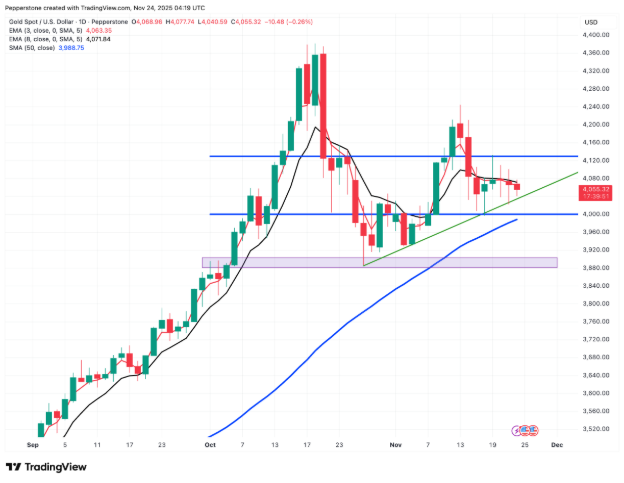By Dilin Wu, Research Strategist at Pepperstone
Gold remains choppy in the short term, with bulls and bears evenly matched. Mixed employment signals, Fed divisions, and geopolitical risks add uncertainty. This week, US retail sales and PPI data could guide the next move for gold.
Over the past week, gold has continued to trade in a sideways range. Structural weakness in September’s US nonfarm payrolls, sudden dovish shifts from Fed officials, and risk-off buying amid geopolitical tension temporarily supported gold. However, missing key economic data combined with internal Fed disagreements has made it difficult for the market to form a consensus, limiting sustained upside for bulls.
This week, the focus will be on September’s US retail sales and PPI, which could provide key guidance ahead of the Fed’s December meeting and offer clues for the next direction of gold.
Technical Observation: Bulls and Bears Neck-and-Neck, Intraday Volatility Rising
From a technical perspective, XAUUSD traded mostly between $4,000 and $4,130 last week. Repeated long wicks on daily candles indicate a tight battle between bulls and bears, with intraday swings clearly amplified.
On Monday’s open, bears took the lead, pushing gold back toward the uptrend line established at the end of October—an important short-term support level for bulls.

If this trendline is convincingly broken, gold could test the $4,000 psychological level and the 50-day moving average, which may offer temporary support before a deeper correction unfolds.
Conversely, if buying pressure returns and short-term sentiment stabilizes, the key to an upward move will be whether gold can break last week’s range top at $4,130 and the mid-November high of $4,250.
Mixed Employment Signals and Fed Divisions
The primary force influencing gold remains market uncertainty over the US economic outlook, which has become more pronounced.
On the employment front, data noise is increasing. September’s nonfarm payrolls rose by 119,000, well above expectations of 50,000, but the previous two months were revised down by 33,000, and the unemployment rate jumped to a four-year high of 4.4%. Meanwhile, initial jobless claims declined, but continuing claims continued to rise.
These conflicting signals make it difficult for the market to assess whether the labor market is cooling or fluctuating, complicating the Fed’s rate path projections.
Fed policy divisions are also becoming more visible. According to the October meeting minutes, most officials believe “further rate cuts could entrench inflation,” with hawks like Collins and Logan reinforcing this view. However, New York Fed Governor Williams unexpectedly signaled a dovish stance last Friday, suggesting room for near-term rate cuts.
As one of the Fed’s “big three,” alongside Powell and Jefferson, Williams usually leans hawkish. His dovish guidance led the market to dramatically repricing December rate cuts from 30% to roughly 70%.
Complicating matters further, key economic releases have been disrupted. The Bureau of Labor Statistics confirmed that the October nonfarm payroll report is postponed, with November’s report delayed until December 16; October CPI was canceled, and November CPI will be released on December 18. In other words, the Fed may have to base its December meeting decisions on outdated September data.
The mix of confusing employment signals, extended data gaps, and sharp revisions to rate cut expectations makes gold’s short-term direction harder to gauge. Yet, this uncertainty continues to support safe-haven demand, providing a floor for prices.
Meanwhile, rising rate cut expectations have pushed US Treasury yields lower, with the two-year yield dipping below 3.5% last Friday, theoretically supporting non-yielding gold. However, the dollar remains strong above 100, limiting upward momentum for gold.

Geopolitical Tensions Keep Safe-Haven Demand Alive
As markets reassess the likelihood of a year-end Fed rate cut, developments in the Russia-Ukraine conflict are also under scrutiny. Recently, US media reported that the Trump team proposed a 28-point Ukraine peace plan covering territorial, military, and diplomatic issues.
In reality, this plan remains far from implementation. Its provisions would require significant concessions from Ukraine, the EU has voiced objections, and Russia has stated it has not discussed the details with the US. Ambiguity in the plan and an unclear path to execution make it difficult for the market to view it as a genuine sign of easing tensions.
Amid persistent geopolitical risks, skepticism over the peace outlook remains. Short-term breakthroughs appear unlikely, supporting safe-haven demand and providing a floor for gold.
US Retail Sales and PPI: What’s Next for Gold?
Overall, gold continued its choppy pattern last week. Mixed released data and delayed upcoming releases make it hard for traders to form a consensus on the Fed’s rate path, keeping trend-following moves limited in the short term. Unless there is a major surprise, gold is likely to remain range-bound ahead of the next Fed meeting.
This week, the US Thanksgiving holiday shortens trading days and reduces liquidity. While major data releases are limited, September retail sales and PPI are key, as they directly reflect economic health and inflation trends, influencing market expectations and gold.
The market expects September retail sales to rise 0.4% month-on-month, slightly below August’s 0.6%, while PPI year-on-year is expected to remain at 2.6%.
If retail sales are soft and inflation remains moderate, rate cut expectations may rise further, potentially pushing gold toward $4,100. Conversely, strong data could temper rate cut bets, putting gold at risk of breaking below $4,000.

